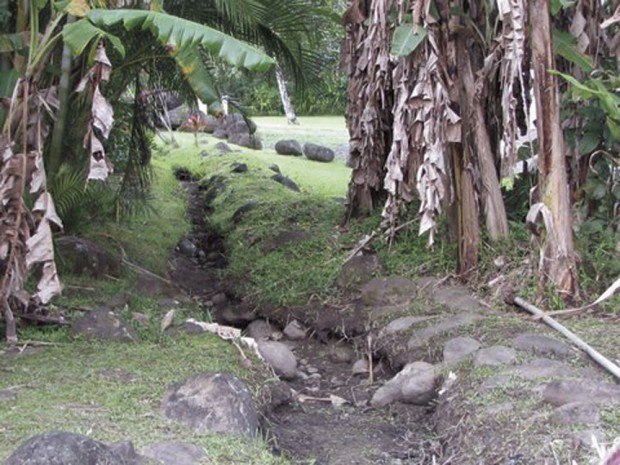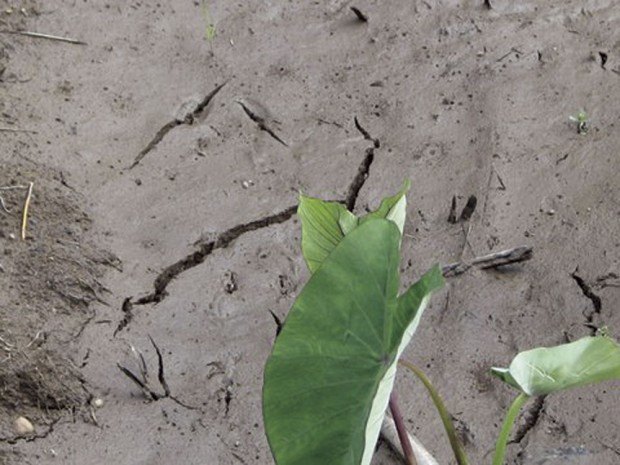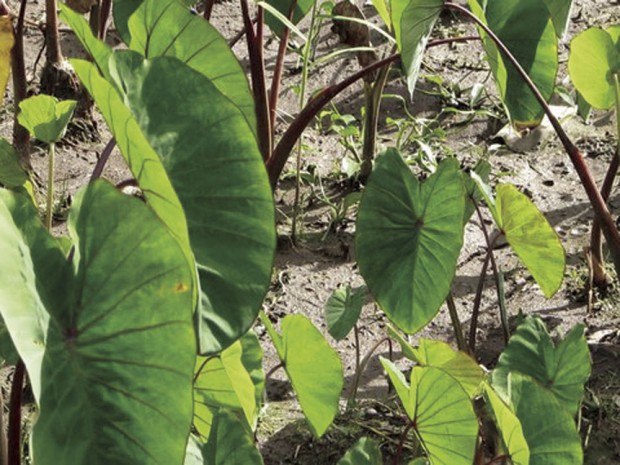Grower claims hydro shutdown impacted taro
WAINIHA — A Wainiha Valley taro grower says she was alarmed when her taro patches suddenly and unexpectedly dried out last month.
“It’s been three days now that no water is in the ‘auwai (irrigation ditch), almost no water in the stream here in Wainiha Valley,” Caren Diamond wrote in a July 28 email to the Department of Health seeking information. “I’m just below the hydro power plant. O‘opu impacted, along with the other creatures … Our taro patches are dry and cracking.”
Alexander & Baldwin, owner of Wainiha Hydro Power Plant, shut down the facility to perform annual maintenance for eight days between late July and early August.
A&B spokeswoman Linda Howe said the facility “gets shut down annually for maintenance for at least a week, sometimes longer.”
“This is a very long standing practice, done since around 1920,” she said. “The hydro can also be tripped offline by the utility, which would stop the flow of water as well.”
Taro ‘hasn’t recovered’
“When it first happened, I didn’t call anybody or do anything,” Diamond said last Wednesday. “I thought it would be coming on in a day or two, as it normally did — but then it didn’t. I wondered if something was wrong … There’s one little stream that comes off of the Wainiha and normally it has good flow.”
So she started asking “old-timers” who live in the valley what was happening. “They said (A&B) normally shuts it off for maintenance but not normally for so long … On the third day is when creatures stared dying.”
She began finding dead o‘opu, a native fish, in the stream along with other animals.
Diamond said there are “certainly” some impacts with hydropower, but issues like timing could be mitigated.
“There’s the heat, the dry summer heat, of July and August,” she said. “That was the exact wrong time to take the water out.”
Diamond questioned why such maintenance couldn’t be performed during wetter or cooler months of the year.
“Eight days with no water, my taro patches grew weeds,” said Diamond, an avid gardener and 32-year resident of Ha‘ena and Wainiha. “My taro patches were very beautiful before then. It hasn’t recovered from this. It will take a lot of manpower to get them back to where they were … This has made a whole lot of work for us.”
A&B’s response
The 3.5-megawatt Wainiha Hydro Power Plant on the North Shore was built in 1906 by McBryde Sugar Company, a subsidiary of A&B, to generate electrical power to drive irrigation pumps in Hanapepe. A 33-mile-long transmission line carries the power from the north to the south of the island.
Today, the power is sold to Kaua‘i Island Utility Cooperative.
According to a 1988 A&B newsletter, the water for the Wainiha plant comes from the Wainiha River and several feeder streams.
Howe said A&B intentionally schedules maintenance and upgrades of the Wainiha hydro during the driest time of the year for two reasons:
“First, out of concern for the safety of the people who do the work, as the entire system is involved — from the diversion dam, forebay, tunnels and ditches, pipelines to the powerhouse itself with its flywheels, turbines, various electrical equipment and tailrace ditch,” she said in an email.
“And secondly, to cause the least disruption in the supply of power to the Kaua‘i community. When rainfall is high, power production is high, thus the loss of clean renewable power to the public would be greater and result in a greater amount of fossil fuel being burned to compensate,” she said. “Thus, there is probably a lesser environmental impact undertaking the maintenance work in the drier times.”
Howe said A&B internal resources claim Diamond does not live along the river or its stream system.
“That property is located alongside our tailrace, which is a manmade ditch that returns water, after it has run through our hydro plant, back to the stream,” she said. “That property does not border the Wainiha Stream. The tailrace is not ‘natural’ and isn’t intended to be a source of water for anyone.”
To Howe’s assertion, Diamond replied: “The only time I ever heard that was from them after I complained.”
Diamond said the irrigation for her taro is natural and part of the traditional ‘auwai system the Hawaiians created centuries ago to specifically feed taro systems.
“The original taro lo‘i are on our property,” she said. “I looked up the Land Commission Award for here and the taro patches are named and numbered. The power plant came after the taro patches.”
Diamond said the water goes from mauka to makai and traverses many people’s taro lo‘i.
DLNR: More info needed
Gary Ueunten, an environmental health specialist for the Clean Water Branch on Kaua‘i, inspected Wainiha on July 29. He confirmed that “the Wainiha hydroelectric plant was undergoing maintenance and the flow of water through the plant was stopped.”
Ueunten did not provide additional comments or information on his findings. He referred The Garden Island to Robert Chong, a planner for the Department of Land and Natural Resources’ Commission on Water Resource Management on O‘ahu.
Chong said in order to speak specifically on the matter, he would need to see the property’s TMK map showing the parcel along with the Land Commission Award — “the actual LCA translated into English.”
Generally speaking, people who live alongside a stream have certain riparian rights, Chong said, certain kuleana or appurtenant water rights under the Great Mahele, Hawai‘i’s land redistribution act during the 1830s and ’40s. It predates the Water Code, he said, and was grandfathered into it.
“There was a land commission that awarded land to the Native Hawaiians and, with this award, they may have kuleana water rights. For a person to claim they have kuleana water rights today, they need to show that that parcel of land has received that from the land commission.”
With hydro, he said, there’s a manmade diversion, an intake and an outtake. Whether it is located on public or private land is an important consideration.
Chong added that the Water Commission is currently in the process of setting a procedure to determine kuleana or appurtenant water rights on Maui.
In service management areas, people who divert water from ditches would be required to have a permit to use the water, he said. If the diversion is located on private property, typically permission must be obtained from the property owner to use the water in the ditch.
Sustainability
Don Heacock, a Kaua‘i state biologist who has spoken out about environmental impact and sustainability issues related to the Wainiha Hydro Power Plant, said the o‘opu nakea are the most culturally important native fish species. They spawn and migrate down river between August and November, he added.
“What triggers these spawning migrations is flood waters,” Heacock said. “There appears to be spawning that takes place on a small level when it doesn’t flood.”
He speculated that when the Wainiha Hydro Power Plant was built more than 100 years ago, its designers didn’t think about what would happen if the turbines were turned off.
“If we were designing one today, we would design it to bypass the turbine to keep water in the river,” he said. “(Wainiha) could be modified.”
The tailrace of the Wainiha plant — where high-pressure water is released from the turbine and into a ditch system — is a quarter to a third of a mile long, he said.
Heacock said he believes the best way A&B can mitigate the power plant’s impact to the o‘opu nakea and other species is to look for partnerships in habitat enhancement and watershed restoration programs through the state, Fish and Wildlife and EPA.
“We need to find creative ways landowners can make projects more sustainable,” he said.
• Vanessa Van Voorhis, staff writer, can be reached at 245-3681 (ext. 251) or by emailing vvanvoorhis@thegardenisland.com.




